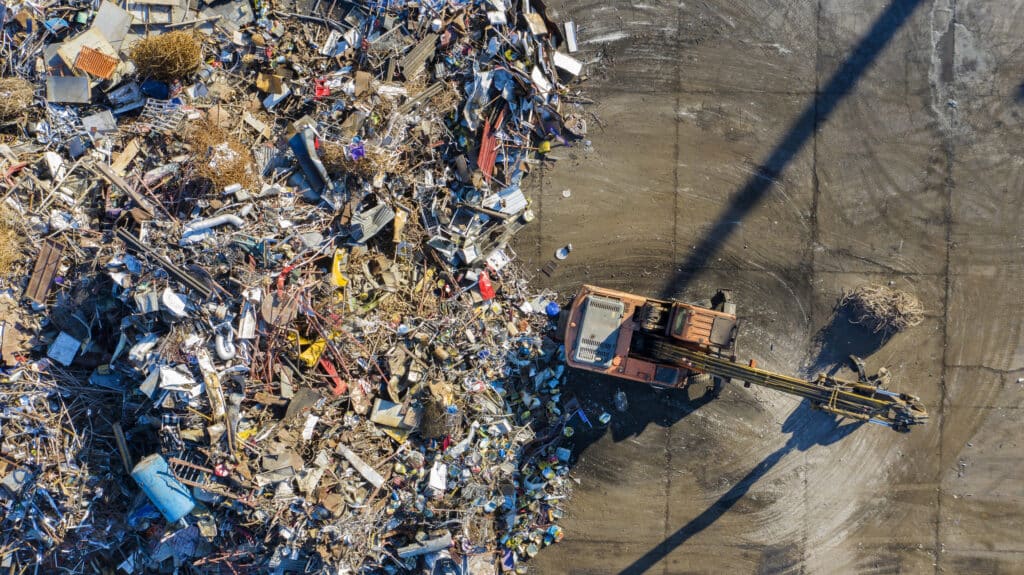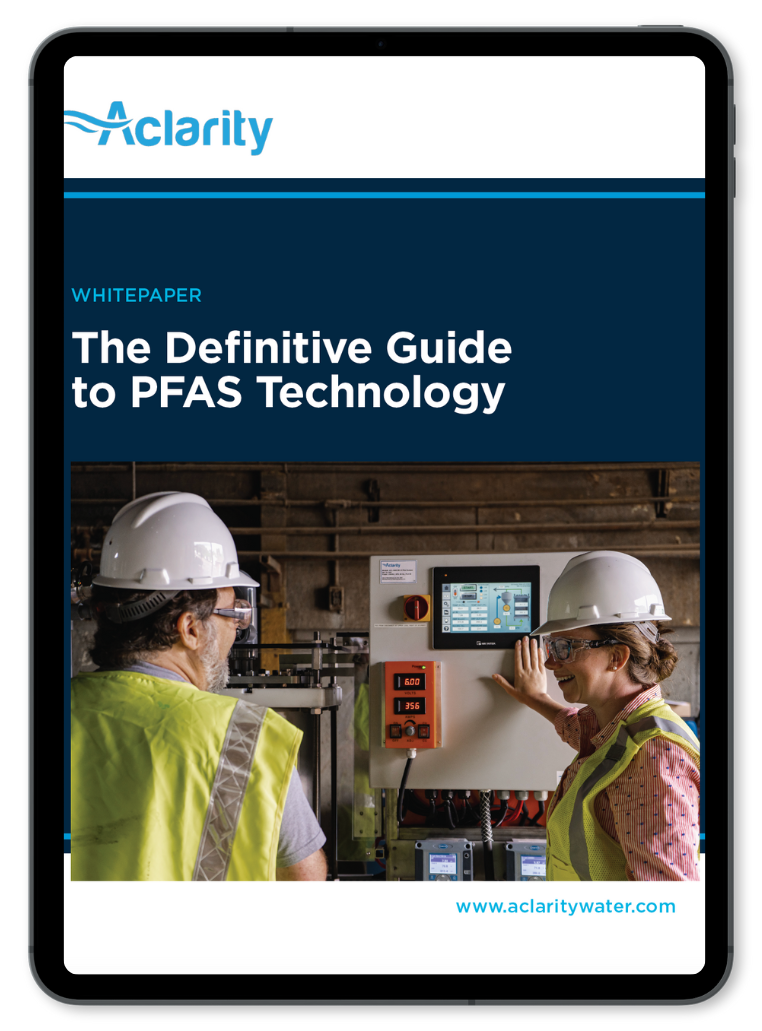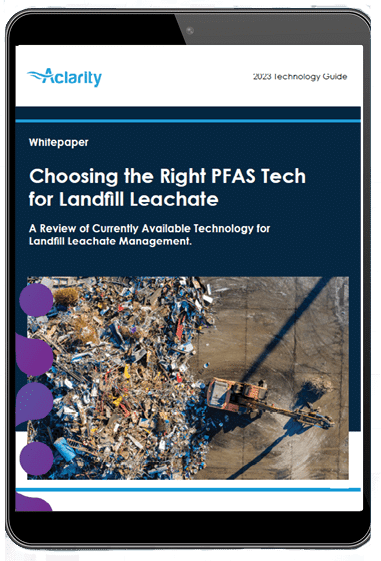A Guide to Treating PFAS in Landfill Leachate
July 21, 2023 | 6 min read
Landfill leachate is a hazardous liquid containing PFAS and other chemicals that can pose risks to human health and the environment. This short article seeks to inform landfill operators on their options for treating PFAS in landfill leachate.

Introduction to Landfill Leachate
Landfill leachate is a liquid primarily made up of rainwater that percolates through layers of waste, picking up different materials within the landfills (including vast amounts of PFAS), resulting in a treacherous concoction of substances, many of which, particularly PFAS, remain there permanently. Modern landfills utilize liners and collection tactics to remove leachate from landfills and the leachate requires treatment before it can be properly disposed of. With the prevalence of PFAS in so many everyday products that end up in landfills, it can be challenging to tackle PFAS removal and management in landfill leachate. However, it is an important step to prevent spreading dangerous chemicals to our drinking water, croplands and even our bodies.
With the large amount of PFAS found in landfills, in addition pending federal regulations, newer PFAS destruction methods have seen an uptick in popularity. These methods destroy PFAS rather than conventional removal and disposal efforts which don’t truly remove PFAS from our environment. So, what technologies are available when a landfill operator uncovers a PFAS issue? In this post, we’ll cover landfill leachate management techniques for the removal and disposal of PFAS along with novel methods that aim to destroy PFAS.

The Definitive Guide to PFAS Technology Whitepaper
Comprehensive guide to understanding PFAS management strategies to reduce risk and safeguard environmental and public health.
Stay current on advantages and disadvantages of technologies available for PFAS:
- Removal
- Disposal
- Destruction
Five PFAS Removal, Concentration and Disposal Options
1. Granular Activated Carbon
The utilization of granular activated carbon (GAC) has emerged as a promising technique for the removal of per- and polyfluoroalkyl substances (PFAS) from landfill leachate if used in a larger treatment train. GAC is a highly porous material with a large surface area that provides an ideal platform for the adsorption of organic and inorganic substances, including PFAS compounds. When the landfill leachate is passed through a bed of GAC, the PFAS molecules in the liquid phase are attracted to the carbon surface through a process called adsorption. The unique physical and chemical properties of GAC, such as its high surface area and affinity for organic compounds, make it an effective sorbent for PFAS removal. The adsorption capacity of GAC for PFAS depends on factors such as contact time, temperature, pH, and the specific characteristics of the PFAS compounds. In general, longer contact times and higher temperatures enhance the removal efficiency. However, pH can also influence the performance of GAC, with optimal removal occurring at neutral or slightly acidic conditions. One advantage of using GAC for PFAS removal is its versatility and applicability to different types of landfill leachate. GAC can effectively treat leachate with varying levels of PFAS contamination, making it a viable option for PFAS remediation efforts in diverse landfill settings. However, it is important to note that GAC is a consumable material, and its adsorption capacity will eventually be exhausted. Proper disposal or regeneration of the spent GAC is necessary to avoid potential re-release of PFAS into the environment.
2. Foam Fractionation
Foam Fractionation is not a removal or disposal option, but a separation technique that exploits the surface-active properties of PFAS compounds. The process involves generating foam by introducing air or gas into the leachate, which leads to the formation of a stable foam layer on top. PFAS compounds preferentially partition into the foam phase due to their hydrophobic nature. By continuously generating and removing the foam, the concentration of PFAS in the leachate can be significantly increased. One of the major advantages of foam fractionation is its ability to achieve high concentration factors, sometimes up to 100,000 times. This is crucial for effectively managing PFAS-contaminated leachate, as it reduces the volume of liquid that requires further treatment or disposal. The concentrated PFAS foam can then be subjected to appropriate disposal methods such as incineration, deep well injection, or solidification. It is important to note that foam fractionation requires careful control and optimization of process parameters, including pH, temperature, and the addition of foam-promoting agents. The efficiency of the process can be influenced by the specific characteristics of the PFAS compounds present in the leachate. It also does not remove the necessary disposal step, so landfill operators will still need to contend with disposing of the concentrated PFAS. Once PFAS is removed or concentrated, landfill operators will need to create an action plan for PFAS disposal.
3. Deep Well Injection
Deep well injection involves storing the PFAS underground in “porous geological formations” per the EPA:
"An injection well is used to place fluid underground into porous geologic formations. These underground formations may range from deep sandstone or limestone, to a shallow soil layer. Injected fluids may include water, wastewater, brine (salt water), or water mixed with chemicals."
This end-of-life option can mitigate PFAS. However, some wells do not accept PFAS waste, and the associated transportation costs may be prohibitive in making this a viable disposal method. Others question the viability and the true cost to the environment. Is it truly removing PFAS from the environment?
4. Solidification
Solidification is one of the methods used for the treatment of PFAS-contaminated soil, sediment, or sludge. The process typically involves mixing the contaminated material with solidification agents or binders to create a stable, less mobile solid matrix. These binders can include materials like cement, clay, fly ash, or other chemical additives that can effectively encapsulate the PFAS compounds, reducing their leaching potential.
By solidifying PFAS-contaminated materials, the risk of PFAS spreading to the surrounding environment is minimized, and the treated material can be safely managed and disposed of in a controlled manner. Some people, though, are objecting to this. Is it just "kicking the ball down the road"?
5. Incineration
PFAS disposal methods that were formerly a feasible choice are now being questioned by many. Incineration may not completely destroy all of the PFAS at temperatures above 1,800°F, allowing some to escape into the atmosphere and the environment. Because of this, the EPA is expected to impose a federal ban on the incineration of PFAS. Several US states have already banned the incineration of PFAS as well as the Department of Defense (DoD) when they released a memorandum that temporarily prohibits the incineration of materials containing PFAS (e.g., aqueous film forming foam and investigation-derived waste). This action is in accordance with Section 343 of the 2022 National Defense Authorization Act (NDAA), which requires the DoD to prohibit the incineration of materials containing PFAS until the DoD issues guidance implementing the EPA’s Interim Guidance on the Destruction and Disposal of PFAS and Materials Containing PFAS, which was released on December 18, 2020. According to memorandum, the DoD is “in the final stages of issuing this guidance and expects to finalize and issue that guidance in the near future.”
So, what is the best way to deal with landfill leachate? In short, it is becoming increasingly apparent that PFAS removal and disposal methods are becoming under intense scrutiny, given the various approaches are not dealing with the problem effectively. Instead, we are seeing the emergence of more innovative approaches that focus on PFAS destruction in landfill leachate rather than disposal.
DOWNLOAD NOW: The Definitive Guide to PFAS Technology Whitepaper
3 PFAS Destruction Options
In recent years, researchers, companies, and other stakeholders have proposed novel destruction solutions to eradicate PFAS. Some newer destruction solutions include the following, led by researchers, startups, and the EPA’s PFAS Innovative Treatment Team:
1. Supercritical water oxidation (SCWO):
SCWO utilizes water at a temperature and pressure above its critical point to create a supercritical state, where it exhibits unique properties and enhanced reactivity. In the SCWO process, PFAS-containing materials are mixed with supercritical water, typically at temperatures above 374°C and pressures above 22.1 MPa. Under these extreme conditions, the PFAS molecules undergo rapid oxidation and decomposition. The combination of high temperature, pressure, and oxygen availability facilitates the destruction of PFAS compounds. While SCWO shows great promise for PFAS treatment, it requires specialized equipment and careful control of operating conditions. Due to the high use of energy for the process, energy recovery may be available with additional system complication.
2. Plasma:
Though primarily lab and bench scale and not yet commercially viable, plasma technology has emerged as a somewhat promising approach for the destruction of per- and polyfluoroalkyl substances (PFAS). Plasma, often referred to as the fourth state of matter, is an ionized gas consisting of highly reactive species. This unique state of matter can be harnessed to efficiently degrade PFAS compounds.
In the plasma treatment process, PFAS-containing materials are subjected to a high-energy plasma discharge. The plasma generates a range of reactive species, including ions, radicals, and UV photons, which interact with PFAS molecules and break down their chemical structure. Plasma technology offers several advantages for PFAS destruction. It operates at ambient or elevated temperatures, eliminating the need for extreme heat or pressure. One large disadvantage is the requirement for large volumes of argon which can be difficult and costly to acquire.
However, further research is ongoing to optimize plasma technology for PFAS destruction, including the development of efficient plasma reactors and understanding the complete breakdown pathways of PFAS compounds.
3. Electrochemical oxidation (EOx):
Aclarity's newer version of electrochemical oxidation (EOx) technology has achieved success in an area where previous EOx methods have failed. In 2022, the technology demonstrated significant effectiveness in combating PFAS contamination by destroying PFAS on-site. The tech also offers additional advantages such as low energy costs (less 50 w-hr/gal), the ability to destroy other contaminants like ammonia, and the capability to treat high salinity wastes.
Moreover, the process stands out for its simplicity. It doesn't necessitate extreme high pressure, high temperatures, or the use of harsh caustic amendments. On-site destruction also eliminates the need for preconcentration, which would otherwise require some form of disposal, potentially off-site through trucking. Why go through the process of concentrating the contaminants first when technologies like Aclarity's can destroy PFAS on-site?
This approach represents a practical and feasible method for completely eradicating PFAS in raw landfill leachate. It can process and destroy PFAS in landfill leachate without any pretreatment. Organizations can utilize Aclarity's technology to eliminate PFAS on-site with minimal maintenance and no need for byproduct disposal.
Conclusion
The main advantage of destruction technologies is the ability to skip the costly steps of PFAS removal and disposal—not only monetary costs, but negative environmental externalities as well. With most solutions only gaining traction in the last 1-2 years, further studies and practical applications are needed. In contrast, Aclarity has been hard at work to perfect the EOx process over the last 6 years, and a string of promising results bode well for stamping out PFAS sooner than later.
Different sites will have various requirements and as always, landfill leachate can require several treatment steps. If you are interested in getting a complimentary PFAS evaluation, fill out the form below:

